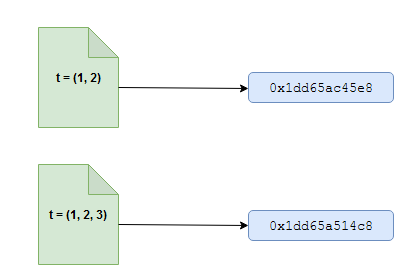Python, immutable data-types again, and memory management →
In an earlier post we saw how Python’s memory management behaves when dealing with immutable objects. In this post, let us see another immutable object, this time a tuple and examine how Python deals with it.
Let us consider a tuple of integer objects t = (1, 2, 3). We see that it references memory address 0x1dd65ac45e8
def mem_addr(item):
return hex(id(item))
t = (1, 2)
print('memory referenced by t: {0}'.format(mem_addr(t)))
What happens if we try to mutate or update the tuple object above, t? We see that it creates a new reference to a new object (at 0x1dd65a514c8), instead of updating the earlier object. And the earlier reference would be reclaimed by the garbage collector.

t = (1, 2, 3)
print('memory referenced by t: {0}'.format(mem_addr(t)))
This is because tuples are immutable objects, more like integer objects we saw in an earlier post.
So, all is clear and good, right? Wait until a future post on tuples again.